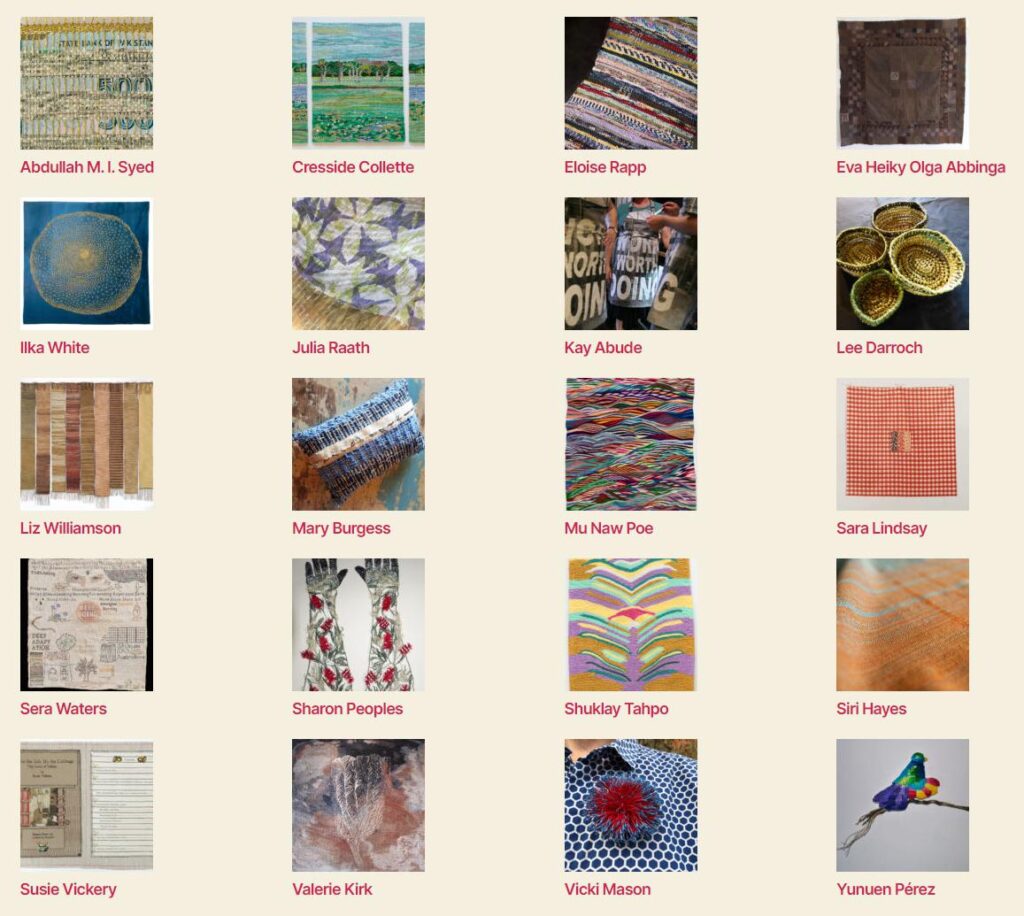
An exhibition of Australia textile art renews the power of weaving to bind the world together.
“Historically, pandemics have forced humans to break with the past and imagine their world anew. This one is no different. It is a portal, a gateway between one world and the next…We can choose to walk through it, dragging the carcasses of our prejudice and hatred, our avarice, our data banks and dead ideas, our dead rivers and smoky skies behind us. Or we can walk through lightly, with little luggage, ready to imagine another world. And ready to fight for it.” Arundhati Roy
Binding is an essential human act of holding things together. Naturally, textiles often figure in how we’ve imagined the creation of the world, such as the Navajo story of Spider Woman. The current pandemic has pulled the world apart, as borders are closed, jobs are lost and doors locked on places where we gather. Emerging from lockdown, the choice is whether to restore what was before, or use this opportunity to re-connect with what’s important—nature, country and a shared humanity.
Twenty Australian textile artists have shared works that skillfully weave together disparate aspects of our world. These works are testaments to what binds us together. Make the World Again has been developed for Crafted Vancouver. Australia was to be the guest country at this year’s festival, which also marks the Canadian Year of Craft. This has been postponed now to 2021, but the works are available to enjoy online.

Nature is a key reference. Valerie Kirk’s Floating fossil uses the slow process of weaving to reflect the time of nature. Susie Vickery’s epic dramatisation of the botanist offers a romantic view of European science, as is reflected in wonder at the “new world”. Vicki Mason interprets the Australian national emblem of the wattle (like Canada’s maple leaf) in a contemporary context of domestic gardens challenged by record-breaking drought. Ilka White creates a map of mind and world with knotted thread. Sharon Peoples embroideries interweave human bodies with the gardens they inhabit. And Sera Waters draws on the tradition of the sampler to reflect on the place of environmental concerns during the lock-down brought on by Coronavirus.
Revival is a strong theme of Australian Aboriginal artists, many of whom share with their Canadian cousins a recovery of cloaks made of animal skin. Lee Darroch is a renowned Aboriginal artist who has revived the use of possum skin cloaks. For his exhibition, she has made some traditional baskets that have combined with Western fabric during her residency at the Australian Tapestry Workshop. Australian-Mexican weaving Yunuen Perez has focused on her Pueblo Mexican ancestry with the creation of a hummingbird, Colibri. And reflecting the rich settler culture of Australia, Eva Abbinga has reconstructed the fabled Rajah Quilt, made originally by convict women on the boat to Tasmania. But with local Aboriginal participation, she has used dyes from local plants to colour the fabric, assisted by her Ukrainian community.
More than half the Australian population has at least one parent born overseas. This enriches our textile crafts. Mu Naw Poe and Shuklay Tahpo are from the Karen ethnic group in Myanmar. Since migrating to Australia they have developed their weaving skills with the assistance of Sara Lindsay and the Australian Tapestry Workshop. Sara’s own work re-weaves a flag from the universal textile of gingham. From a background in traditional designs, they have now been able to produce individual artworks using a vibrant range of colours and eccentric weft technique. Other artists in this exhibition use textiles to sustain a connection between Australia and their home country. Another ATW graduate Cresside Collette has produced tapestries that lovingly reproduce landscapes from her homeland, Sri Lanka. Abdullah Syed has used Pakistani weaving to produce works from the universal material of US dollars.
Being located in the Eastern hemisphere has provided Australian artists with access to remarkable skills. Liz Williamson has been travelling between Australia and India for decades, teaching and learning skills of weaving and dyeing. Her Weaving Eucalyptus is a collaborative work made especially for this exhibition, woven from natural dye workshops in India. The photographer Siri Hayes has a similar work that was part of a project in Kanazawa to blend together Australian eucalypt and Japanese indigo dyes. The gold leaf in the portrait evokes the famous ice-cream served on Kanazawa streets. Eloise Rapp’s work recreates the Pang Jai, a quintessential fabric of Hong Kong’s urban puzzle. And Julia Raath has worked extensively with block printers in India to produce works that reflect the duality of truth.
Finally, the intimacy of textiles in our lives has provided a basis for Mary Burgess’ practice which uses a textile associated with a deceased loved one to produce mementos that are part of the healing process.
The artists talk about their work at the soft opening on 21 May 2020:
Make the World Again has been supported by the Australia Council of the Arts.

